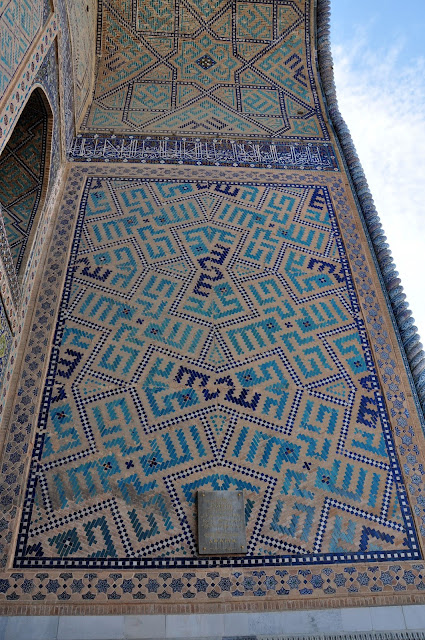Central Asia: Uzbekistan - Things to See/Do in Samarkand Part 1
By Cubie - February 03, 2016
 |
| Ceiling detail of Tilla-Kori Medressa |
Ok, back to Samarkand. Well, the buildings are impressive (yes, they are impressive despite they are overly restored) but I feel it lack the rustic friendly feel of Khiva or the interesting and neighbourhood feel of Bukhara. Here goes...
Old Town
1. Registan Square
Registan Square, the square of three medressas actually means "sandy place" or "desert" in Uzbek. The three medressas are - Ulughbek, Sherdor and Tilla-Kori.
The original medressa is Ulugbek Medressa, finished in 1420 is located on the west side. Ulugbek or his personal/real name - Mirza Muhammad Taraghay bin Shahrukh, was the grandson of Amir Timur (Amir meaning general) who was also a Timurid ruler. Ulugbek was also an astronomer and mathematician. It was said the Ulugbek used to teach in this medressa in Registan Square.
The facade of the medressa was completed with two tall minarets at the side, and star looking motives symbolizing sky and astronomy.
 |
| Inside courtyard where I munched on some buns as snack :P |
The opposite building to Ulugbek Medressa is Sher-Dor (Lion) Medressa. It was finished in 1636 (yes, more than 200 years later) under the order of Yalantush Bahadur, the emir of Samarkand at the time. It is said that Sher-Dor Medressa was meant to "mirror" Ulugbek Medressa but it turned out to be taller though not really noticable.
Upon construction, the medressa was named in honor of Emir Yalangtush Bahadur but somehow the name didn't quite stick. The building was renamed to Sher-Dor after the images on the portal - two roaring felines that look like tigers but supposed to be lion. These tigers looking lions supposedly carry a sun on their backs and heading after a white deer.
The detail of the building is beautiful, yes, albeit reconstructed.
Entering Sher-Dor Medressa, there are many souvenir stalls...
We reckon after construction the building will look like new, I prefer it looking more rustic (i.e. less new) though.
As we were scouting around, sis pointed to a dome and told me to look.
It looks like some growth protruding out of the dome, no? Grin - maybe we a bit juvenile.. haha.
Though from the outside, it looks totally different ok.... see below! :)
A decade later, another medressa was commissioned in Registan, also by Emir Yalangtush Bahadur. This medressa is Tilla-Kari, also known as Gold-Covered Medressa was completed in 1660. This medressa is build in between Ulugbek Medressa and Sher-Dor Medressa.
It's easy to see why it's name means "gold-covered" once you see the glittering domed chamber (see the first photo). Actually there's a lot of glittering in the chamber.
2. Bibi-Khanym Mosque
Once upon a time, a queen who wanted to surprise her king who was returning from a victorius war campaign decided to give him a mosque. She invited the best architect from the empire for the construction. Captivated by the beauty of the young queen, the architect was madly in love and refused to continue working on the construction until he was given the permission to kiss the queen. Apparently the kiss left an imprint on the cheek of this beautiful young queen.
When the king returned, he was shocked by the beauty of the mosque but also noticed the mark on his queen's cheek. The king was furious and ordered the execution of the architect and decreed that women should henceforth wear veils so as not to tempt other men. Other version of story stating that the king threw both his favourite queen and the architect off a tower.
The young beautiful queen was no other than Bibi-Khanym and the king, Timur. I am curious how this queen looks like though. Lol.
In the interior courtyard, you'll see this big marble Quran stand. Local lore has it that any woman who crawls under the stand will have lots of children. Maybe there were many women who actually attempted to crawl under the narrow stand because at the time of our visit, there is a chain around this Quran stand to prevent anyone from going near it. Hahah.
3. Shah-i-Zinda
 |
| I spy with my little eyes - 3 women enjoying some soft serve |
 |
| Getting to the next level |
 |
| Inside Shirin Beka Mausoleum, built by Timur for his sister Shirin Beka oko |
Of the many mausoleum, the start attraction seem to be the grave of Prophet Muhammad's cousin, Kusama Ibn Abbs. It was said that he was the one who preached Islam in that region in 640 and spent 13 years in Samarkand. In the Middle Ages, a pilgramage to the grave of "The Living King" (Ibn 'Abbas) was equate to Mecca hajj.
4. Siyob Bazaar
This bazaar is strategically adjacent to the Bibi-Khanym Mosque. We actually visited this on our last day in Samarkand and bought the yummy apricot nuts as snack ;)
 |
| Some photos while waiting for our turn to make a purchase |
Side note: Happy CNY!

































0 comments